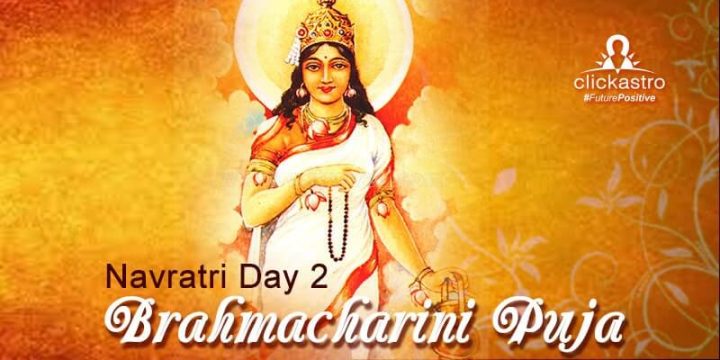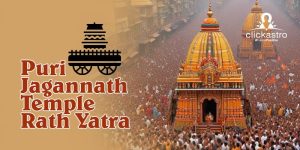Contents[hide]
Read about Navratri Day 1: Ghatasthapana and Shailputri Puja
The 2nd day of Navratri is dedicated to Goddess Brahmacharini, the second form of Nava Durga. She bestows eternal bliss through wisdom of the Supreme Self. She is also known by other names such as Tapascharini, Aparna, and Uma In the incarnation of Goddess Sati, Goddess Parvati was born to King Daksha. Goddess Brahmacharini is worshipped as the unmarried form of Goddess Sati. She is represented as the lady who practiced the most difficult penance and challenging austerity, for which she was given the name Brahmacharini. Goddess Brahmacharini is illustrated wearing white robes and walking barefoot. She has two hands and carries a rudraksha mala (rosary) in her right hand and a kamandala (an oblong waterpot) in her left. Her penance for Lord Shiva during her forest life is represented by the rudraksha mala. The Kamandal represents her final years of penance and that she consumed only water. The lotuses on the Goddess’s body represent wisdom, and the white saree symbolises purity. Being an ascetic, she is always portrayed barefoot. According to spiritual practices, Goddess Brahmacharini is believed to control Lord Mangal, the provider of all fortunes, and represents the Swadhistana chakra. Furthermore, Goddess Parvati is said to have performed extreme penance for thousands of years to obtain Lord Shiva as her husband. Her austerity continued with unwavering determination despite the extreme and challenging weather. Goddess Tapasyacharini was born as a result of this. She survives solely on Bilwa leaves and water. Lord Brahma later blessed her after seeing her intense penance, and eventually, Goddess Brahmacharini married Lord Shiva.
The story of Goddess Brahmacharini
Devi Brahmacharini, an incarnation of the Goddess Durga, is commemorated on the second day of the nine-day Navratri festival. After self-immolating in her previous birth as Sati, Goddess Parvati took birth again, this time to the Himalayas, the king of the mountains. During this birth, Goddess Parvati also came to be known as Goddess Brahmacharini. Brahmacharini is derived from the words “Brahm” meaning austerity or penance and ‘Charini’ meaning a devout female worshipper. Once when Sage Narada visited Goddess Parvati she asked him about getting married to Lord Shiva. Sage Narada advised her that to get married to Lord Shiva in this birth too, she needed to perform severe penance. Goddess Parvati decided to any manner of penance possible to marry Lord Shiva. She performed severe penance which went for thousands and thousands of years. She only ate fruits and flowers for the first thousand years, vegetables for the next thousand years, and dried leaves for the next three thousand years. At once Parvati decided that she was ready for any kind of penance. She went into severe penance. It was no ordinary Tapasya, her Tapasya went on for thousands and thousands of years. For the first thousand years, she only ate fruits and flowers, for the next hundred years, she only ate vegetables, for the next three thousand years she only ate dried leaves. Her penance was exceptional. Nobody had ever witnessed anything like this austerity, and after 3000 years of eating only leaves, she went on to eat nothing. She gave up water and food, and the primary objective of her life became extreme penance. She became extremely weak and malnourished as a result. When Goddess Parvati’s mother visited her, she was devastated and cried out aloud ‘Oh! ma.’ It is believed that for this reason, Goddess Parvati is also known by the name of Uma. When she stopped eating leaves, she also earned the name of Aparna – one who lives without leaves. Witnessing the harsh penance that lasted many years, Lord Brahma visited Goddess Parvathi and blessed her saying that Lord Shiva was also content with her penance, and they could marry in this birth. Brahmacharini represents incredible selflessness, penance, serenity, and sanctity. On the second day of Navratri, we pray to her for immense fortitude to be completely focused on our penance towards God, what we love, our dedication, and solitude. People pray for happiness, prosperity, and peace. Worshippers observe the Navratri fast for the entire nine days fast without food and, in some cases, water. On such days, they worship Goddess Brahmacharini for fortitude so that they can remain focused and deal with their desiresOn the second day of Navratri, on the Dwitiya Tithi, worshippers conduct the puja rituals for Goddess Brahmacharini. They offer flowers, Akshat, roli, sandalwood, and other offerings to deities during worship. The deity should be bathed in milk, curd, melted butter, honey, and sugar and offerings of pistachio-based dessert are also made. Following that, the devotees offer paan, betel nut, and cloves. It is believed that by worshipping Goddess Brahmacharini one can always remain calm and happy and shall not be afraid of anything. Given below is a puja Vidhi steps for performing the Brahmacharini puja.
- Following the installation of the Goddess’s idol or picture, the following pujas are performed to invoke the Goddess.
- First, an atma puja is performed to purify oneself.
- The worshipper then applies tilak to their forehead and drinks holy water from their palms.
- Taking the water in one’s hand, a Sankalp (vow) is made to the Goddess to observe the Navratri fast with complete devotion and piety.
- The deity is then offered flowers. The feet of the Goddess are then washed with holy water.
- The deity is then anointed in a mixture of camphor, water, pure cow milk, ghee, honey, sugar, and panchaamrita.
- After that, the Goddess is dressed in a Saree or cloth.
- Sandalwood tilak is applied to the deity. The Goddess is offered kumkum, kajal, Durva leaves, and Bilwa leaves.
- An aarti is performed with the dhoop and deep, and prasad offered to the deity which is then distributed to the devotees.
Significance of Brahmacharini Puja
Goddess Brahmacharini embodies love, devotion, knowledge, and wisdom. She represents simplicity. Goddess Brahmacharini’s name means “the one who performs penance,” and the word “Brahm” refers to penance. Legend has it that she was born in the Himalayas and was inspired in her thinking by Sage Narada. As a consequence, she performed extreme penances in order to win Lord Shiva as her husband. Goddess Brahmacharini is said to confer wisdom and knowledge to her devotees. Her puja bestows great fortune and eliminates all obstacles from our path. On the second day of Navratri, worshipping Goddess Brahmacharini helps to remove obstacles from their path. Goddess Brahmacharini is revered alongside Lord Shiva. Praying to the Goddess can help one improve their ethical values. Worshiping Goddess Brahmacharini also grants one the tenacity to achieve their goals.Goddess Brahmacharini Puja Mantra
Brahmacharini Mantra
Om Devi Brahmacharinyai Namah|| Dadhana Kara Padmabhyamakshamala Kamandalam |Devi Praseedatu Mayi Brahmacharinyanuttama ||
Stuti
Ya Devi Sarvabhuteshu Goddess Brahmacharini Rupena Samsthita |Namastasyai Namastasyai Namastasyai Namo Namaha ||
Dhyana
Vande Vanchhitalabhaya Chandrardhakritashekharam।Japmalakamadalu Dharabrahmacharini Shubhama ||
Gauravarna Swadhishthanasthitta Dwitiya Durga Trinetram |
Dhawala Paridhana Brahmarupa Puhspalankara Bhushitam Pyodharam ||
Kamaniya Lavanya Smeramukhi Nimannabhi Nitmbneem ||
Stotra
Tapashcharini Twahi Taptreya Nivaraniyam|Brahmarupadhara Brahmacharini Pranamamyaham||
Navcagrabhedanee Twahinivaishvarya Pradaayaneem|
Dhanasukhada Brahmacharinee Pranamamyaham ||
Shankara Prayaatvamhi bhukti mukti yaadini |
Shantidaamaanadaa Brahmacharini Pranamamyaham ||
Read about Navratri Day 3 – Chandraghanta Puja







